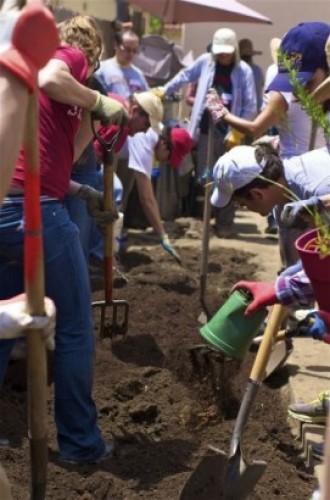If you want to save the world, what's the best way to go about it?
The question plagued me all through grad school and sent me off to track relief and development efforts and organizations of all sizes in Colombia, Malawi, and elsewhere around the world. Across the board, it was clear that bigger was almost never better. Smaller, more flexible, organic efforts were the ones most likely to be sustainable and have a genuine and transformative impact in a community.
I was therefore intrigued to learn about L.A. Green Grounds, an informal organization dedicated to “changing turf into edible gardens in South Los Angeles,” that seemed to embody the organic, smaller-is-better approach.
Leader Craig Dietrich describes the effort as a “labor of love.”
He created L.A. Green Grounds with his wife, Vanessa Vobis, and other gardening activists in 2010. They sought to build a corps of volunteers willing to set up gardens for those in South L.A. who wanted them. Volunteers come together at monthly "dig-ins," where they spend up to six hours digging up a neighbor's yard and planting edible crops and herbs. Whenever possible, the gardens are put in front yards so that people in the area can see them as they walk by and, hopefully, come to view gardens as beautiful and appropriate replacements for lawns.
First-timers are not always aware of how challenging it can be to start a large edible garden. Said Dietrich, “Until you get a garden, it is tough to see [what it entails].”
The organizers decided that those that wanted Green Grounds to put gardens in their own yards would be best served by first participating in a dig-in for someone else. This way, participants could get a better sense of not only how it would look and what it would produce, but also the commitment it takes to maintain a sizable garden.
The commitment of the new garden owners is essential to the success of the project.
Reason being, L.A. Green Grounds has not, to date, formalized their organization to seek out grants. The seedlings planted in the new gardens come from Craig and Vanessa's own garden or that of Florence Nishida (a master gardener and one of Green Grounds' founders).
The tools are also their own. The mulch and compost brought to the dig-in site are free from the city, but require that one of the organizers make the effort to transport it to the site. The only thing the homeowner is responsible for is sourcing any fruit trees that they would like to see planted and inviting their neighbors to join in the dig. In short, the organizers have invested a lot of themselves in making their vision a reality in the hopes that those entrusted with new gardens will carry that vision forward.
They seem to have been fortunate in that regard with at least two of their garden recipients.
I observed the May 12 dig-in at Judy's home in Leimert Park and was struck by how thrilled she was to have a new garden. She had attended Florence Nishida's master gardening classes and decided she needed one for herself. She and previous garden recipient (and nearby resident), Maggie, talked about how beautiful Maggie's garden was and how many neighbors had stopped by to ask about the new front yard.
When others listening in to our conversation asked about whether or not it might be "tacky" to have a front yard replaced with compost and herbs, the women immediately countered the question with a resounding "No!"
For Judy, it's all about "mind change." Having gardens out front and accessible to neighbors, she said, "gives them good ideas...and shows people that it's do-able. Even if you can't do all of it, [you can] do part of it."
Better yet, she said, "it gives the neighborhood a nice smell."
For more about L.A. Green Grounds, please visit their website.







